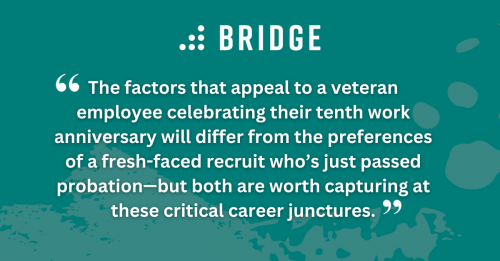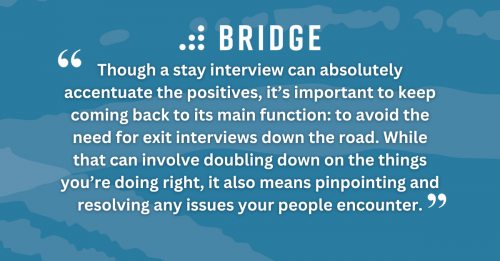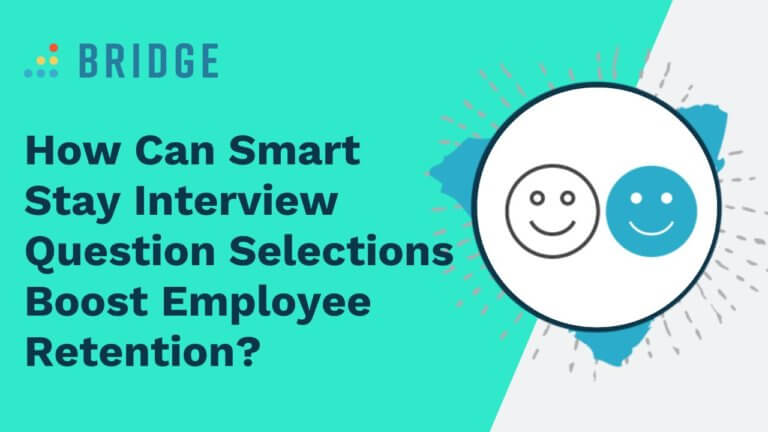“Why are you still here?”
In some scenarios, this question isn’t always appreciated. It’s certainly no way to round off a visit from the in-laws. When it comes to improving your employee engagement and satisfaction, however, there’s no better place to start than by asking your workers why they’re motivated to stick around. If you’re doing something right, you’ll probably want to know what it is!
That’s the driving force behind stay interviews. The scale of the Great Resignation, which set a new quit rate of 3%, has highlighted the value of robust retention strategies. The wrong approach, however, can do more harm than good—which is why many organizations are gauging their success by turning to the wellsprings of wisdom found in their own employees.
So, what makes a good stay interview—and how can you conduct them effectively? Read on to find out.
What Is a Stay Interview?
A stay interview is a constructive, retention-boosting conversation that typically takes place between a manager and an employee. Its main goal is to provide managers with a thorough understanding of why the employee stays with their organization—and alert managers to any areas for improvement.
While stay interviews should look to prompt concrete and actionable responses, and while they therefore benefit from a certain amount of structure, that doesn’t mean they need to be formal. If your performance management platform facilitates frequent 1:1s between managers and their reports, it can be helpful to infuse stay questions within these more casual interactions.
GET THE LOWDOWN ON 1:1s: ‘One-on-One Meetings: How the Personal Touch Improves Workplace Performance’
Why Do Stay Interviews Matter?
If you want to understand the value of a stay interview, the clue’s in the name. A good interview will give you the information you need to convince your people to stay, either by ratifying the things you’re doing right or highlighting areas to address.
This has become a pressing concern in light of the changing attitudes toward workplace dissatisfaction embodied by the Great Resignation. Increasingly, employees have shown a willingness to walk away from roles that don’t supply respect, remuneration, or perk-related rewards in exchange for their loyalty. In fact, Pew research found that 63% of workers who resigned in 2021 cited low pay as their primary push toward a new career.
In response, and even as economic circumstances change, employers have been working to keep their people happy—but how do they know whether or not their efforts are working?
The UK-based CIPD, for example, found in its Autumn 2022 Labor Market Outlook survey that 36% of employers have increased wages to combat the cost-of-living crisis.
While this sounds like a great way to increase loyalty and improve retention, especially in light of the above Pew insights, separate CIPD research suggests that monetary rewards aren’t a “silver bullet” for achieving strong retention rates.
The reasons for financial incentives falling short can, according to the World Economic Forum, include the unfair distribution of financial benefits. Alternatively, it may be that money can’t make up for an unfulfilling work environment. Whatever the reason may be, employers need to find out whether this kind of expensive retention strategy is having the desired effect. Just as importantly, they need to figure this out before employees leave—rather than waiting until a resignation letter lands in their inbox.

Stay Interviews vs Exit Interviews
In terms of structure and content, stay interviews can bear a striking resemblance to exit interviews. Like a stay interview, an exit interview is a means of working out what you’re doing right and highlighting aspects of the employee experience that need improvement. However, the similarities between the two processes don’t mean they’re interchangeable.
Unlike exit interviews, stay interviews have a preventative effect. If you’re asking the right questions and you’re quick off the mark, you can nip any emerging problems in the bud and retain an employee whose dissatisfaction might otherwise have been revealed through their parting words. In fact, stay interviews exist so that exit interviews don’t have to.
Compared to a well-thought-out stay interview, exit interviews quickly resemble the HR equivalent of locking the stable door after the horses have bolted—or at least one horse, anyway!

How to Conduct a Stay Interview Effectively
In many ways, the efficacy of your stay interviews will be impacted by your actions leading up to them. Have you cultivated a culture of trust and openness among your people? Are your employees intimidated by the thought of speaking their minds? Do you have a history of actioning solutions to employee concerns?
Your interviews can only be effective if your people are prepared to answer honestly and thoroughly, and this is entirely dependent on the atmosphere and environment you’ve created. Plus, according to EY, 92% of employees claim that culture has a bearing on whether they stay—so the better your culture, the more likely you are to receive positive feedback in your interviews!
Assuming that your people feel comfortable enough to speak their minds, you’ll then need to decide when to prompt them. While stay questions can (and should!) form part of your frequent 1:1s, there are certain milestone moments that put your people in a great position to reflect on why they stay at your organization.
For example, the factors that appeal to a veteran employee celebrating their tenth work anniversary will differ from the preferences of a fresh-faced recruit who’s just passed probation—but both are worth capturing at these critical career junctures. It’s a great way to ensure that employees of all experience levels are being catered to.
By the same token, you’ll also want to make sure you’ve heard from every employee. Offering stay interviews to a select few doesn’t just give you an incomplete picture—it can also be interpreted as favoritism, which might have the unintended effect of turning people off your organization even as you try to improve it!

FIND OUT HOW TO IMPROVE YOUR CULTURE | ‘4 Ways to Create a Culture of Conversation for Your Organization’
5 Stay Interview Questions to Get Your People Thinking
While you might want to supplement your stay interviews with questions geared towards the specific quirks of your department, organization, or industry, there are plenty of always-useful options to have on hand.
Once you’ve opened your interview by explaining its purpose and establishing that you’d like to improve your interviewee’s working conditions, consider the following five questions:
1) What Gets You Excited About Coming Into Work?
Like many stay interview questions, this is an open-ended opener that allows your people to take whatever avenue fits the bill. It also allows you to quickly gauge your interviewees’ satisfaction levels. If they can give you some specifics, that’s great. If they’re struggling to answer, you can focus your interrogative energies on figuring out why that is.
2) Do We Do Enough to Recognize Your Contributions?
There’s a difference between loving your work (or parts of it!) and getting appropriately praised for it. According to Gallup, 40% of employees only receive recognition a handful of times per year, demonstrating just how easy it is to neglect this vital morale boost.
As such, stay interviews are the perfect opportunity to make sure your people get the kudos they deserve for a job well done.
3) Have You Ever Thought About Quitting?
Though a stay interview can absolutely accentuate the positives, it’s important to keep coming back to its main function: to avoid the need for exit interviews down the road. While that can involve doubling down on the things you’re doing right, it also means pinpointing and resolving any issues your people encounter.
Don’t be afraid to ask for guidance on how to address those issues, either. If your interviewee can articulate a problem that nearly caused them to quit, follow up by asking them direct and specific questions regarding how you can fix the problem.
CONCERNED ABOUT WORKPLACE DISSATISFACTION? | ‘6 Simple Ways to Prevent Quiet Quitting and Drive Employee Engagement’
4) What Might Tempt You to Leave Our Organization?
If the previous question covers the ‘push’ factors driving your people away, this one tackles the ‘pull’ factors that could cause your people to be drawn elsewhere.
This kind of question opens up your interview to omissions and factors your employees are missing that might not otherwise get mentioned. It’s easy to miss these subtler issues, especially amid a slew of questions that focus on the tangible specifics of your workers’ lives.
Plus, by identifying and addressing these kinds of temptations, your people will be less susceptible to offers made by other organizations. It’s a great opportunity to show your employees that the grass really isn’t greener anywhere else!
5) Do You Feel Supported to Grow and Develop New Skills?
Nominally, a stay interview is about assessing the views of your employees in the here and now—but you’ll want to ensure that even the happiest of your people feel supported well into the future.
A recent report from Josh Bersin points out that 45% of participants in 2022’s Great Resignation didn’t just quit—they went to new industries. Finding out how to give your workers in-house opportunities through skills development and talent mobility is a great way to keep your people around no matter where their ambitions lie.
As such, these informal chats are a great opportunity to iron out any issues with your learning management system, your eLearning content, or your options for talent mobility.
Find Out What Makes Your People Tick With Bridge
Bridge makes stay interviews a breeze with a performance platform that puts impactful conversation and human connection at its heart. Nurture an atmosphere of trust and honesty with frequent 1:1 meetings and ensure you never miss an opportunity to assess your workers’ wellbeing.
Plus, it’s easy to bolster your stay interviews with Bridge’s employee engagement surveys. Gain snappily incisive insights into employee satisfaction by giving your workforce a voice that can’t be ignored.




